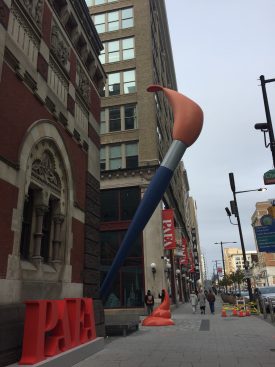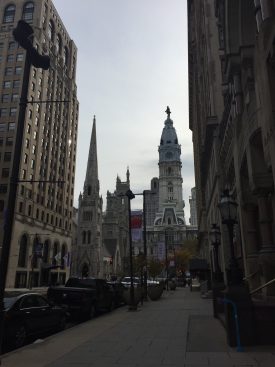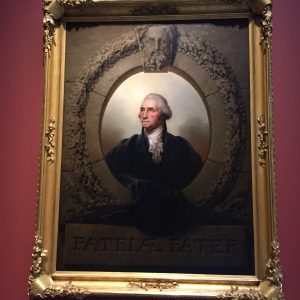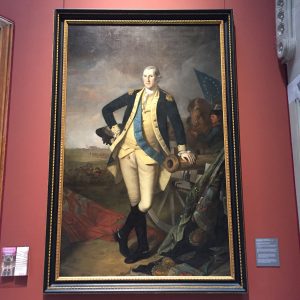


My visits to Philadelphia are infrequent during the school year, and for most of my college career I barely explored the city at all. Spending last summer in the city gave me much more confidence in my navigational abilities, and it also turned Philadelphia from an intimidating mass of faceless buildings into something resembling a home. The Sunday before Thanksgiving break, I found myself with no urgent work to complete and no appointments to keep, so I decided to visit the city and spend a day recharging. As the train lumbered into the station I listened to two elderly women reminisce about how they used to go to the ballet on Friday nights. Autumn sunlight made the fibers of their felt hats look like halos. We filed out onto the platform at Suburban Station and I lost them in the crowd.
I emerged to find the Made in Philadelphia Holiday Market in Dilworth Park. There were stalls selling homemade soaps, candles, jewelry, and hand-stitched silk embroideries. I had a great time admiring all the crafts on display. There was also ice-skating and a carousel with colored lights and music. It was a beautiful day, hovering on the edge of winter, but not too cold. All the snow has melted, so hardly any puddle-hopping was required.
 Going into the city by myself makes me feel like a different person, some mysterious urbanite on a mission, especially now that I am familiar enough with center city to walk around without needing to consult any map. On this particular day I was heading to the Pennsylvania Academy of the Fine Arts. One block north of City Hall, PAFA is located in a stunning historic building—and you can’t miss the giant paintbrush out front. The museum has free admission on Sundays from now through March 31, as a part of the temporary exhibition of work by Rina Banerjee, a contemporary artist whose installations and sculptures deal with globalization, environmental degradation, and the relationship between East and West, among other themes.
Going into the city by myself makes me feel like a different person, some mysterious urbanite on a mission, especially now that I am familiar enough with center city to walk around without needing to consult any map. On this particular day I was heading to the Pennsylvania Academy of the Fine Arts. One block north of City Hall, PAFA is located in a stunning historic building—and you can’t miss the giant paintbrush out front. The museum has free admission on Sundays from now through March 31, as a part of the temporary exhibition of work by Rina Banerjee, a contemporary artist whose installations and sculptures deal with globalization, environmental degradation, and the relationship between East and West, among other themes.
 It was disheartening to hear a museum-goer mutter to his friend, while looking at one of Banerjee’s pieces, “Why is this in a museum of American art?” Banerjee, born in India and raised in England, has lived and worked in the United States since the early 1990s. Her dissonant, eclectic, and at times grotesque aesthetic may not be for everyone, but there can be no question that her body of work speaks to problems that are of utmost importance to Americans and their place in the world. The juxtaposition between Banerjee’s work and the permanent collection is certainly dramatic, and such contrast is a valuable counterpoint to the early colonial narratives that PAFA otherwise showcases.
It was disheartening to hear a museum-goer mutter to his friend, while looking at one of Banerjee’s pieces, “Why is this in a museum of American art?” Banerjee, born in India and raised in England, has lived and worked in the United States since the early 1990s. Her dissonant, eclectic, and at times grotesque aesthetic may not be for everyone, but there can be no question that her body of work speaks to problems that are of utmost importance to Americans and their place in the world. The juxtaposition between Banerjee’s work and the permanent collection is certainly dramatic, and such contrast is a valuable counterpoint to the early colonial narratives that PAFA otherwise showcases.
Banerjee’s works are interspersed throughout the museum, alongside the permanent collection of American art. PAFA was founded in 1805 to “promote the cultivation of the Fine Arts in the United States of America.” The museum houses artwork that both creates and challenges a unified national identity, a focus embodied by three portraits of George Washington. An iconic Gilbert Stuart painting faces two portraits by Philadelphia painters Charles Wilson Peale and Rembrandt Peale (his son). Why has Stuart’s vision of Washington persevered as the definitive image of the founding father while the Peales’ have faded from our collective imagination? Stuart’s portrait depicts Washington as an older man. The brushstrokes are softer and more romanticized. Washington looks mature, standing by his books and writing tools. The Peales paint Washington with bolder, brasher, and defined lines. On the battlefield or steely-eyed behind the weight of classical tradition, Washington is more vital but perhaps less wise.


 Walking through the galleries reminded me of an English class I took my sophomore year in which we read foundational texts of the American 19th century canon and discussed the mythography that they construct. Many early thinkers theorized the pre-European America as an Edenic and untouched place, where the indigenous people frolicked childlike in nature’s bounty. This view is represented in the dreamy pastoral landscapes that hang salon-style in several of PAFA’s galleries. They are beautiful, and stir up emotions of wanderlust and awe. The tiny human presences in the vast wilderness are little civilizing dots, just on the verge of taming the land.
Walking through the galleries reminded me of an English class I took my sophomore year in which we read foundational texts of the American 19th century canon and discussed the mythography that they construct. Many early thinkers theorized the pre-European America as an Edenic and untouched place, where the indigenous people frolicked childlike in nature’s bounty. This view is represented in the dreamy pastoral landscapes that hang salon-style in several of PAFA’s galleries. They are beautiful, and stir up emotions of wanderlust and awe. The tiny human presences in the vast wilderness are little civilizing dots, just on the verge of taming the land. One very early painting shows a menagerie of exotic animals grouped in the foreground among jungle-like flora, while just in the very background we can see a trading party of Europeans offering cloth and written documents to a group of indigenous people, who have laid down their weapons. Another painting shows the fabled scene of William Penn signing a treaty with the Lenape people, an event now memorialized in Philadelphia’s Penn Treaty Park.
One very early painting shows a menagerie of exotic animals grouped in the foreground among jungle-like flora, while just in the very background we can see a trading party of Europeans offering cloth and written documents to a group of indigenous people, who have laid down their weapons. Another painting shows the fabled scene of William Penn signing a treaty with the Lenape people, an event now memorialized in Philadelphia’s Penn Treaty Park. On my way out I stopped by the temporary exhibit in the Richard C. von Hess Works on Paper Gallery. “‘Alter’ing American Art, a selection of work from PAFA’s Linda Lee Alter Collection of Art by Women,” which will stay up through December 16, is both a thought-provoking complement to the permanent collection and an excellent self-contained show. The few small rooms contain an incredible breadth of style and emotion that proves, as if we needed evidence, that the full range of the human personality is also found within women. Sadness, joy, community, solitude, confusion, desire, nostalgia, humor, and subversion: women’s art is not necessarily more personal or domestic, but I do feel that the works in this exhibit were more pointed, less art-for-art’s-sake than the art upstairs. I thought, maybe if your voice has been repressed, then once you finally are able to take possession of it, you feel a more acute need to utilize it. I was especially fascinated by the tiny painting “Girl Searching,” by Gertrude Abercrombie, which reminded me of many insomniac nights walking back from the library; and “Untitled (Gray Cloth Face)” by Alicia Henry, a piece of textile art that suggests a deep and silent grief.
On my way out I stopped by the temporary exhibit in the Richard C. von Hess Works on Paper Gallery. “‘Alter’ing American Art, a selection of work from PAFA’s Linda Lee Alter Collection of Art by Women,” which will stay up through December 16, is both a thought-provoking complement to the permanent collection and an excellent self-contained show. The few small rooms contain an incredible breadth of style and emotion that proves, as if we needed evidence, that the full range of the human personality is also found within women. Sadness, joy, community, solitude, confusion, desire, nostalgia, humor, and subversion: women’s art is not necessarily more personal or domestic, but I do feel that the works in this exhibit were more pointed, less art-for-art’s-sake than the art upstairs. I thought, maybe if your voice has been repressed, then once you finally are able to take possession of it, you feel a more acute need to utilize it. I was especially fascinated by the tiny painting “Girl Searching,” by Gertrude Abercrombie, which reminded me of many insomniac nights walking back from the library; and “Untitled (Gray Cloth Face)” by Alicia Henry, a piece of textile art that suggests a deep and silent grief.

“Girl Searching” Gertrude Abercrombie 1945

“Untitled (Grey Cloth Face)” Alicia Henry n.d.
It struck me that all of the pieces of art were small in size, relative to the vast canvases that I’d seen upstairs. Women have long been denied the time and space to create, perhaps painting at night, using leftover materials, or waiting until later in life to start their careers. Their art is often relegated to “craft” or “handiwork.” Nonetheless, without access to the same materials or training as their male counterparts, women artists refuse to be silenced, expressing themselves with dazzling intensity and passion. I absolutely loved this exhibit and highly recommend a trip.

“Cotton Pickers” Clementine Hunter n.d.

“Black Sheep of the Family” Andrea Joyce Heimer 2014
After leaving the museum, I walked to the Rittenhouse area, where I spent about an hour wandering and window shopping. I enjoyed browsing in the brand new “Shakespeare and Co.,” an offshoot of the New York City bookstore, and eavesdropping on the booksellers’ lively debate about the new “Fantastic Beasts” movie. After stopping in a few other stores and strolling past Rittenhouse square—and running into a recent Bryn Mawr alum—it was time to make my way back to Suburban Station and catch a train back to Bryn Mawr.
Spending time in Philadelphia is a great opportunity and resource for Bryn Mawr students, but unfortunately the city often seems inaccessible, especially to younger students. Not only because of a lack of time, but also, frankly, our public transportation system is confusing! I encourage first-year (and older!) students to step outside their comfort zones and explore Philadelphia sooner than I did. You don’t have to spend a lot of money to enjoy many of the hidden gems our city has to offer. If anyone has recommendations of interesting places to explore, or would like to hear about more of my favorite Philadelphia spots, please leave me a comment!



 Hello! I’ve been neglecting my blog lately because of the immense amount of academic work that has been taking precedence in my life. Looking back at my planner from the last couple of months, my days don’t seem all that full, but of course I don’t write down all the hours I spend working on projects, reading, and studying. Tomorrow I must turn in my proposal for my senior English thesis. The proposal is the result of a semester’s worth of work. The entire
Hello! I’ve been neglecting my blog lately because of the immense amount of academic work that has been taking precedence in my life. Looking back at my planner from the last couple of months, my days don’t seem all that full, but of course I don’t write down all the hours I spend working on projects, reading, and studying. Tomorrow I must turn in my proposal for my senior English thesis. The proposal is the result of a semester’s worth of work. The entire 















